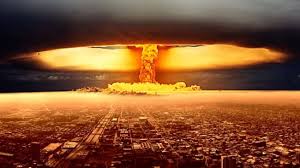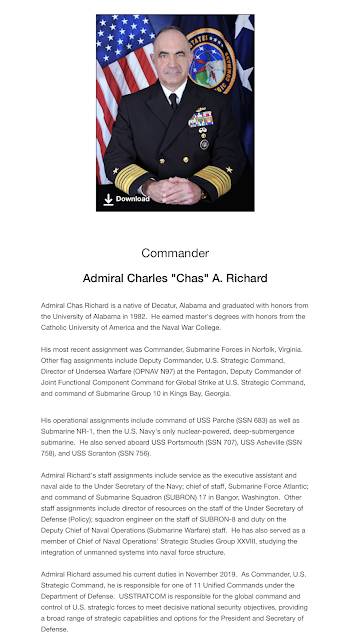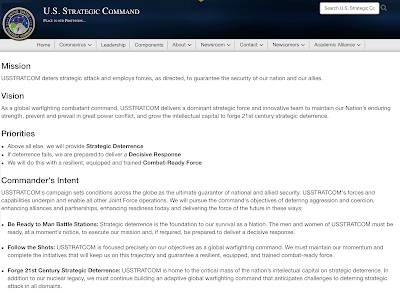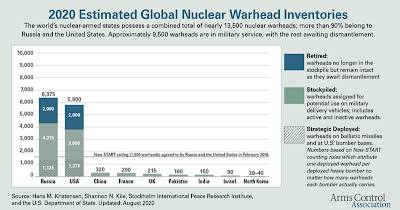
This article was last updated on April 16, 2022
Canada: ![]() Oye! Times readers Get FREE $30 to spend on Amazon, Walmart…
Oye! Times readers Get FREE $30 to spend on Amazon, Walmart…
USA: ![]() Oye! Times readers Get FREE $30 to spend on Amazon, Walmart…
Oye! Times readers Get FREE $30 to spend on Amazon, Walmart…
In a recent edition of the United States Naval Institute's Proceedings magazine, an American Admiral clearly revealed why the United States military believes that it needs nuclear weapons. Let's look at what he said and some background on his current military posting.
In his February 2021 commentary entitled "Forging 21st Century Strategic Deterrence", Admiral Charles A. Richard opens with this statement:
"Since the collapse of the Soviet Union, the Department of Defense (DoD) has not had to consider the possibility of great power competition, crisis, or direct armed conflict with a nuclear-capable peer. Unfortunately, the current environment no longer affords us that luxury. The implications of today’s competition and the associated risk of great power crisis or direct armed conflict are profound; they affect nearly every fundamental assumption we make about the use of armed force in the defense of the nation and its allies. Until we, as a department, come to understand, if not accept, what we are facing and what should be done about it, we run the risk of developing plans we cannot execute and procuring capabilities that will not deliver desired outcomes."
He notes that he "bristles" when the Department of Defense accuses the U.S. military being "stuck in the Cold War" and claims that the department is "well past the Cold War".
He then makes this comment on the Department of Defense's "nuclear dimension":
"Our recent experiences against non-nuclear-armed adversaries have allowed us to believe nuclear use is impossible and not worthy of attention. At the U.S. Strategic Command, we assess the probability of nuclear use is low, but not “impossible,” particularly in a crisis and as our nuclear-armed adversaries continue to build capability and exert themselves globally."
So, who are these "adversaries" (as though we couldn't guess)?
"While DoD’s focus has been on counterterrorism, Russia and the People’s Republic of China (PRC) have begun to aggressively challenge international norms and global peace using instruments of power and threats of force in ways not seen since the height of the Cold War—and in some cases, in ways not seen during the Cold War, such as cyberattacks and threats in space. Not surprisingly, they are even taking advantage of the global pandemic to advance their national agendas. These behaviors are destabilizing, and if left unchecked, increase the risk of great power crisis or conflict. We must actively compete to hold their aggression in check; ceding to their initiatives risks reinforcing their perceptions that the United States is unwilling or unable to respond, which could further embolden them."
According to Admiral Richar, here the key aspects of Russian and Chinese aggression that needs to be countered:
1.) Russia – "More than a decade ago, Russia began aggressively modernizing its nuclear forces, including its non-treaty-accountable medium- and short-range systems. It is modernizing bombers, intercontinental ballistic missiles (ICBMs), submarine-launched ballistic missiles (SLBMs), nuclear-powered ballistic missile submarines, warning systems, command-and-control (C2) capabilities, and the doctrine to underpin their employment—in short, its entire strategic force structure. This modernization is about 70 percent complete and on track to be fully realized in a few years. In addition, Russia is building new and novel systems, such as hypersonic glide vehicles, nuclear-armed and nuclear-powered torpedoes and cruise missiles, and other capabilities. And its leaders have not been reticent to leverage these capabilities to coerce its neighbors. During the annexation of Crimea in 2014, President Vladimir Putin reminded the world of Russia’s nuclear weapon capabilities, both through words and deeds, to warn against any attempts at reversing the outcome."
2.) China – "The PRC also continues to invest heavily in its nuclear capabilities. Its strategic dyad of ICBMs and SLBMs will soon become a triad, with the completion of a nuclear-capable long-range bomber. China is building new land-based, road-mobile ICBMs, providing its forces more flexibility and capability. The PLA Navy Jin-class ballistic-missile submarines carry up to 12 SLBMs each. China has built new warning and C2 capabilities and improved its readiness. Further, China’s nuclear weapons stockpile is expected to double (if not triple or quadruple) over the next decade…
Acting in a responsible manner is incumbent upon any great power. For China, we must pay attention to PRC’s actions more than its stated policies. While the PRC has maintained a “No First Use” policy since the 1960s—contending it will never use a nuclear weapon first—its buildup of advanced capabilities should give us pause. This policy could change in the blink of an eye. Beijing is pursuing capabilities and operating in a manner inconsistent with a minimum deterrent strategy, giving it a full range of options, including limited use and a first-strike capability.
Throughout the commentary, Admiral Richard refers to nuclear weapons no less than 27 times.
Now, let's look at just who Admiral Charles Richard is and his current posting. Admiral Richard just happens to be the Commander of the United States Strategic Command (USSTRATCOM) as shown in this summary of his experience:
USSTRATCOM mission and priorities are as follows:
USSTRATCOM is headquartered at Offut Air Force Base located in Nebraska and is one of elelvn unified commands in the U.S. Department of Defense. It is responsible for nuclear operations/strategic deterrence and is responsible for space operations as well as missile defense. While the ultimate authority to laugh a nuclear attack resides with the president, the commander of USSTRATCOM is to provide advice about the options for the use of nuclear weapons to the president.
Given that the subject of this posting was the potential use of nuclear weapons and Admiral Richard's concern about maintaining nuclear superiority over the two nations that are threatening the United States current position as the world's superpower, here is a graphic showing the estimated number of nuclear weapons according to the Arms Control Association:
With this comment from the man whose responsibility it is to advise the president on the use of America's nuclear arsenal:
"There is a real possibility that a regional crisis with Russia or China could escalate quickly to a conflict involving nuclear weapons, if they perceived a conventional loss would threaten the regime or state. Consequently, the U.S. military must shift its principal assumption from “nuclear employment is not possible” to “nuclear employment is a very real possibility,” and act to meet and deter that reality. We cannot approach nuclear deterrence the same way. It must be tailored and evolved for the dynamic environment we face."
…the leap toward a global nuclear catastrophe is more likely than it has been since the early 1990s when the Soviet Union and the United States were facing off against each other particularly since Washington is feeling increasingly threatened as the multipolar world evolves.
You can publish this article on your website as long as you provide a link back to this page.




Be the first to comment